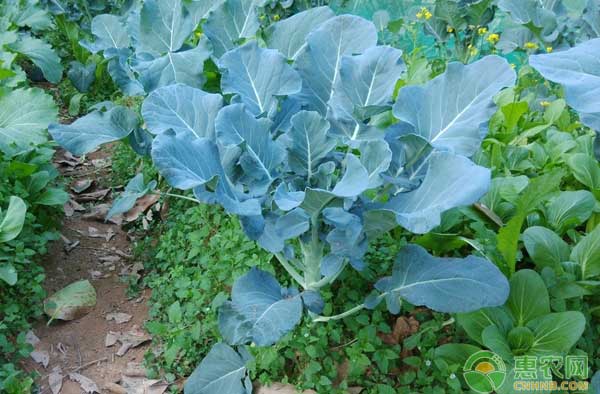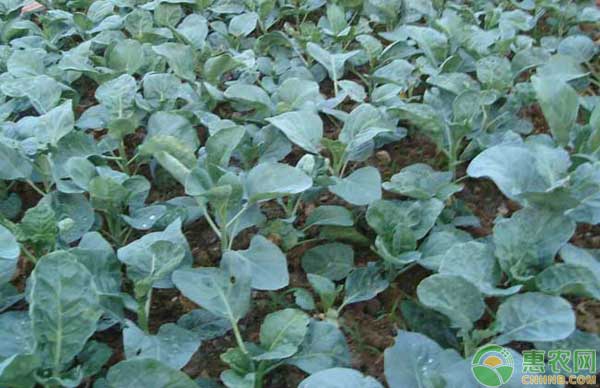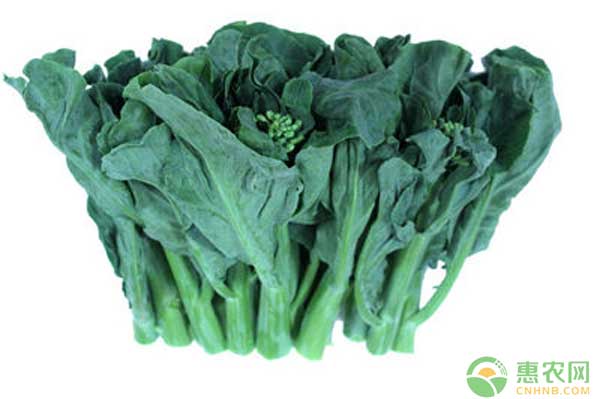How to grow golden green mustard blue? High-yield cultivation techniques of golden green mustard blue
Speaking of kale, everyone is familiar. In the past few years, Guangzhou Academy of Agricultural Sciences has produced a new generation of golden green mustard, which has strong resistance, high yield, excellent quality, high purity, low seed production cost, and heterosis. Strong, neat, and so on. Here is a brief introduction to the cultivation techniques of the golden green mustard blue.

1 Characteristic characteristics
Golden green mustard blue is a hybrid generation, early and mid-maturing, sowing until the initial harvest of 61 days, the main harvest for 8 days. Strong growth, plant type erect, compact, plant height 32.0 cm, plant width 35.0 cm; leaves oval, dark green, leaf length 22.5 cm, width 16.5 cm, petiole shorter, length 5.0 cm; The twitching is neat, the flower ball is large, the flower is green, the color is green, the main ridge is 23.5 cm high, the thickness is 2.3 cm, the main è–¹ is 165 g, the vegetable stalk is tight and straight, the quality is crisp and sweet, the fiber is small, the commodity Good overall traits and excellent quality. The output is high, with a yield of 1,030 to 2 000 kg per 667 m2. The field is heat-resistant, sturdy, cold-resistant, strong against stress, resistant to viral diseases, black rot, soft rot, downy mildew, and strong in disease resistance. For the common traditional type, it can be sidelined.
2 Cultivation key technologies
2.1 timely seeding
The suitable sowing date in South China is from mid-February to mid-March, and sowing in August-November.
2.2 Cultivate strong seedlings
Can be broadcast live, 667 m2 with a seed amount of 50 ~ 100 g, but the seedling transplanting method is appropriate. Choose a land with high dryness, convenient drainage and irrigation, and no seedlings with the same vegetables and less underground pests. The ratio of nutrient soil preparation is generally about 70% for soil, 25% to 28% for organic fertilizer, and 2% to 3% for superphosphate. It is best to use fish pond mud and paddy soil for the soil, and use fully decomposed humus and manure for organic fertilizer.
Cover with about 0.5 cm of humus or soft substrate after sowing, then cover with straw or shading net and then pour water. It is advisable to use water to keep the soil moist. When 30% of the seed germ is exposed to the soil surface, the cover is removed in time. Appropriate control of moisture after emergence to prevent the formation of tall seedlings. When the seedlings are intensive, the seedlings are spawned in time to prevent the occurrence of squatting and prevention of rickets. In order to cultivate strong seedlings, thin human urine or 0.05% urea solution is poured once every 3 to 5 days after 2 true leaves, but pay attention to thin application, and then spray water to prevent fertilizer damage. If the seedlings appear to be prolonged or grow young, it is necessary to reduce watering and enhance ventilation and light transmission.
During the hot and rainy season, seedlings or scaffolding should be carried out in the greenhouse to cool down and prevent rainstorms. Generally, the height of the bamboo shed is 0.5-1.0 m, which is slightly wider than the surface of the raft. The bamboo frame is covered with black or silver-gray shade nets, which can not only cool the surface, but also prevent the rainstorm from hitting the surface, resulting in untidy emergence. In order to improve the survival rate of the colonization and slow down the seedlings, the shading nets are reduced or removed every day for 7 days before planting, and the seedlings are started to prepare for transplanting to the field.
2.3 Implementation of rotation
Choose a field that is not a vegetable of the same family, preferably with rice or other aquatic crops. After the previous harvest, it is helpful to increase the permeability of the soil and reduce pests and diseases.

2.4 Applying base fertilizer
667 m2 of fermented farmyard manure 1 000~1 500 kg, 30 kg of superphosphate and 25 kg of compound fertilizer. The base fertilizer should be applied shallowly, and it is generally used when it is mixed with the soil evenly during the preparation of the soil.
2.5 Timely colonization
The seedlings suitable for colonization are generally 20 to 25 days old, or have 4 to 5 true leaves. And sprayed the anti-fungal medicine once every 2 days before planting, and drenched the water half a day before planting.
The golden green mustard blue is compact, with a row spacing of 20 cm × 20 cm or 20 cm × 25 cm; 10 000 to 1 000 plants per 667 m2. Cultivation in summer and autumn or spring and summer cultivation, suitable for close planting, cultivation in autumn and winter, should be properly planted.
When planting, remove weak seedlings and diseased seedlings, and choose to plant in the sunny or cloudy afternoon. After planting, the root water should be poured, so that the seedlings are firmly anchored in the soil and quickly resume growth. In case of high temperature weather during planting, the sunscreen should be pulled to cool down and promote slow seedlings.
2.6 Diligence
Topdressing should be done early, diligently, and thinly. The first top dressing was carried out 7 days after the seedlings were planted and the seedlings were applied, and 15 kg of urea was applied per 667 m2, which could be applied or diluted with water. The second and third top dressings were carried out before and during the bud period. Each 667 m2 was applied with 15 kg of urea and 15 kg of compound fertilizer, which could be applied in combination with cultivating loose soil. After collecting the main shovel and continuing to harvest the side shovel, the fourth top dressing can be applied between the plant and the plant after the main hoe is harvested with 15 kg/667 m22 of compound fertilizer. In addition, the top dressing can also be diluted with water by decomposing human excrement urine and sprayed once every 7 days.
Watering the seedlings before slow seedlings, when the temperature is high, choose to water in the morning and evening; when the temperature is low, choose to water at noon on sunny days. It is advisable to water the soil to keep it moist.
2.7 Special management due to time and place
In the summer, it is best to use shade nets to cool down and cultivate. During the formation period of the rapeseed meal, the pupa gradually becomes fine and thick, but the base is thin and the upper stem is thick and large, and the top and bottom are light, and the plant is easy to fall or break. After the rain, the soil is easy to be knotted, and the soil should be ploughed in time. In case of acid rain or foggy weather, it should promptly wash away the fog and acid rain to reduce the decay of commercial vegetables.
2.8 timely harvest
If you want high quality and high yield, you must harvest it at an appropriate time. When the main color is green and fresh, the leaves are fresh and tender, and the height of the main stalk is flush with the height of the outer leaves, it is called Qikouhua. At this time, it is suitable for harvesting, and it is suitable for harvesting in the morning or evening in sunny or cloudy days. Park it in a cool place away from light and collect it as soon as possible. The golden green mustard blue continues to harvest the side stalks after harvesting the main stalk, which can greatly increase the total output. When harvesting the main sputum, 2 to 3 side buds of the base are selected, and the side stalks are grown and continue to be harvested.

2.9 Integrated pest control
It can be sterilized by seeds, rotated, dried in the field, planted with scaffolding crops or food crops, taken with new soil or sterilized soil, seedlings with insect nets, regularly sprayed with pesticides, timely drainage, timely thinning, thin fertilization, and full heap Measures such as decomposing organic fertilizers and avoiding watering at noon in hot weather to prevent pests and diseases.
Common pests and diseases include rickets, soft rot, black rot, downy mildew and hanging silkworms, cabbage caterpillars, and yellow-striped fleas. In the early stage of the disease and when the pests are most active or at the low age, the pesticides are used, and the pesticides and low-toxicity pesticides and their compounding agents, such as Bt preparations, Bacillus thuringiensis, and agricultural streptomycin, are used alternately.
The above is the high-yield cultivation technology of Golden Green Mustard Blue. The content is for reference only. If you want to know more about agricultural technology, please pay attention to Hui Nong School!
Edta Salts,Disodium Edta Powder,Ferric Sodium Edta Trihydrate,Iron Sodium Edta Trihydrate
Wuxi Yangshan Biochemical Co.,Ltd. , https://www.yangshanchem.com